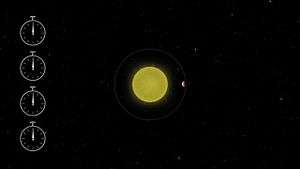Transit-timing variation

Transit-timing variation is a method for detecting exoplanets by observing variations in the timing of a transit. This provides an extremely sensitive method capable of detecting additional planets in the system with masses potentially as small as that of Earth.[1][2][3] "Timing variation" asks whether the transit occurs with strict periodicity or if there's a variation.
The first significant detection of a non-transiting planet using transit-timing variations was carried out with NASA's Kepler telescope. The transiting planet Kepler-19b shows transit-timing variation with an amplitude of 5 minutes and a period of about 300 days, indicating the presence of a second planet, Kepler-19c, which has a period that is a near-rational multiple of the period of the transiting planet.[4][5]
In 2010, researchers proposed a second planet orbiting WASP-3 based on transit-timing variation,[6][7] but this proposal was debunked in 2012.[8]
Transit-timing variation was used to discover Kepler-9d and gained popularity by 2012 for confirming exoplanet discoveries.[9]
References
- ↑ Miralda-Escude (2001). "Orbital perturbations on transiting planets: A possible method to measure stellar quadrupoles and to detect Earth-mass planets". The Astrophysical Journal. 564 (2): 1019. arXiv:astro-ph/0104034
 . Bibcode:2002ApJ...564.1019M. doi:10.1086/324279.
. Bibcode:2002ApJ...564.1019M. doi:10.1086/324279. - ↑ Holman; Murray (2004). "The Use of Transit Timing to Detect Extrasolar Planets with Masses as Small as Earth". Science. 307 (1291). arXiv:astro-ph/0412028
 . doi:10.1126/science.1107822.
. doi:10.1126/science.1107822. - ↑ Agol; Sari; Steffen; Clarkson (2004). "On detecting terrestrial planets with timing of giant planet transits". Monthly Notices of the Royal Astronomical Society. 359 (2): 567–579. arXiv:astro-ph/0412032
 . Bibcode:2005MNRAS.359..567A. doi:10.1111/j.1365-2966.2005.08922.x.
. Bibcode:2005MNRAS.359..567A. doi:10.1111/j.1365-2966.2005.08922.x. - ↑ Invisible World Discovered, NASA Kepler News, 8 September 2011
- ↑ Sarah Ballard; Daniel Fabrycky; Francois Fressin; David Charbonneau; Jean-Michel Desert; Guillermo Torres; Geoffrey Marcy; Burke; Howard Isaacson; et al. (2011). "The Kepler-19 System: A Transiting 2.2 R_Earth Planet and a Second Planet Detected via Transit Timing Variations". arXiv:1109.1561
 [astro-ph.EP].
[astro-ph.EP]. - ↑ Planet found tugging on transits, Astronomy Now, 9 July 2010
- ↑ G.Maciejewski; D.Dimitrov; R.Neuhaeuser; A.Niedzielski; St.Raetz; Ch.Ginski; Ch.Adam, C.Marka; M.Moualla; M.Mugrauer (2010). "Transit timing variation in exoplanet WASP-3b". arXiv:1006.1348v1
 [astro-ph.EP].
[astro-ph.EP]. - ↑ M Montalto; et al. (Nov 2, 2012). "A new analysis of the WASP-3 system: no evidence for an additional companion". MNRAS. arXiv:1211.0218
 . Bibcode:2012MNRAS.427.2757M. doi:10.1111/j.1365-2966.2012.21926.x.
. Bibcode:2012MNRAS.427.2757M. doi:10.1111/j.1365-2966.2012.21926.x. - ↑ The Transit Timing Variation (TTV) Planet-finding Technique Begins to Flower